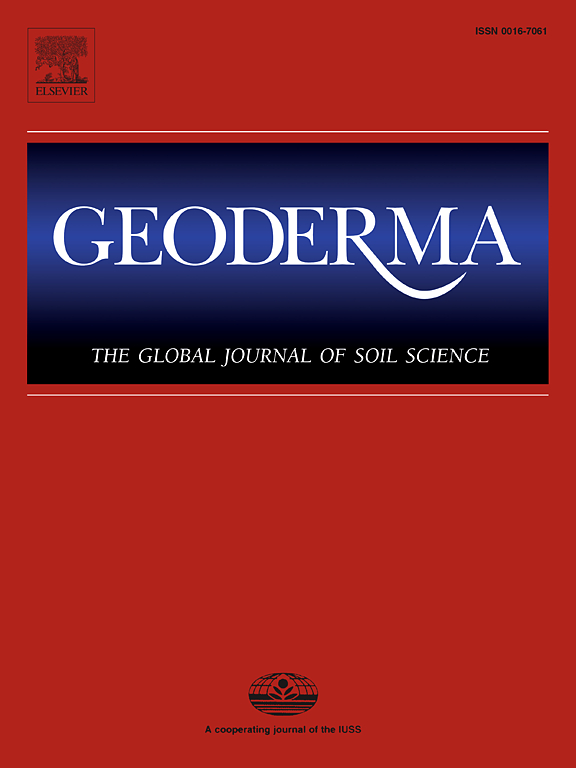Tree species richness affects the trophic structure of soil oribatid mites via litter functional diversity and canopy cover: Evidence from stable isotope analysis (15N, 13C)
IF 5.6
1区 农林科学
Q1 SOIL SCIENCE
引用次数: 0
Abstract
Tree species richness affects biodiversity and ecosystem functioning. Investigating its effect on soil animals and their trophic ecology is crucial for understanding soil food web functioning. Despite this, the relationship between tree species richness and soil microarthropods trophic structure has rarely been evaluated. Here, we investigated the effects of tree species richness (1, 2, 4, 8, 16, 24 species) on soil oribatid mites at an experimental field site in the subtropics (BEF-China). We measured the impacts of tree species richness and oribatid mite functional traits, including body mass and reproductive mode, on oribatid mite trophic ecology using stable isotopes (15N, 13C). Moreover, we inspected if litter functional diversity, litter quality (C/N ratio) and canopy cover affect oribatid mites. The results highlighted that tree species richness influenced oribatid mite trophic ecology through litter functional diversity and canopy cover. High litter functional diversity increased the average and range of Δ15N signatures indicating an increase in trophic position and trophic plasticity of oribatid mites with increasing litter diversity. More open canopy was associated with lower Δ13C signatures and a larger range in Δ13C signatures indicating that soil food webs become more complex when light conditions are more variable. Further, high litter C/N ratio increased the average and range of 15N signatures indicating that low litter quality results in less taxa living as decomposers and more taxa living as fungal feeders or predators. Maximum Δ15N values were generally lower in parthenogenetic than sexual taxa indicating that parthenogenetic taxa more often function as primary decomposers feeding on plant litter, whereas sexual species more often function as secondary decomposers feeding on microorganisms. The Δ15N range was also higher in sexual than in parthenogenetic species indicating that sexual taxa cover a broader range of feeding types than parthenogenetic taxa. Oribatid mite species with a larger body mass had lower Δ15N and Δ13C signatures indicting that they feed on plant litter more intensively than smaller species which feed on microorganisms or live as predators more intensively. Overall, the results indicate that litter functional diversity and data on canopy cover should be included in forest management practices to modulate soil microarthropod trophic structure.
树木丰富度通过凋落物功能多样性和冠层盖度影响土壤甲螨的营养结构:来自稳定同位素分析(15N, 13C)的证据
树种丰富度影响生物多样性和生态系统功能。研究其对土壤动物及其营养生态学的影响对了解土壤食物网的功能至关重要。尽管如此,树种丰富度与土壤微节肢动物营养结构之间的关系很少被评估。本研究在亚热带试验田研究了树种丰富度(1、2、4、8、16、24种)对土壤甲螨的影响。利用稳定同位素(15N, 13C)测量了树种丰富度和甲螨功能性状(包括体重和繁殖方式)对甲螨营养生态的影响。此外,我们还考察了凋落物功能多样性、凋落物质量(C/N比)和冠层盖度对甲螨的影响。结果表明,树种丰富度通过凋落物功能多样性和冠层盖度影响甲螨营养生态。高凋落物功能多样性增加了Δ15N特征的平均值和范围,表明甲螨的营养地位和营养可塑性随着凋落物多样性的增加而增加。更开放的冠层与更低的Δ13C特征和更大的Δ13C特征相关,这表明当光照条件变化更大时,土壤食物网变得更复杂。此外,高凋落物C/N增加了15N特征的平均值和范围,表明低凋落物质量导致以分解者身份生活的类群减少,以真菌食性或捕食者身份生活的类群增加。孤雌生殖分类群的Δ15N最大值普遍低于有性生殖分类群,这表明孤雌生殖分类群更多地以植物凋落物为主要分解者,而有性生殖分类群更多地以微生物为次要分解者。性繁殖的Δ15N范围也比孤雌繁殖的大,表明性繁殖的类群比孤雌繁殖的类群覆盖的取食类型范围更广。体型较大的甲螨的Δ15N和Δ13C特征值较低,表明它们以植物凋落物为食,而体型较小的甲螨则以微生物为食或以捕食者为食。综上所述,凋落物功能多样性和林冠盖度数据应纳入森林管理实践,以调节土壤微节肢动物的营养结构。
本文章由计算机程序翻译,如有差异,请以英文原文为准。
求助全文
约1分钟内获得全文
求助全文
来源期刊

Geoderma
农林科学-土壤科学
CiteScore
11.80
自引率
6.60%
发文量
597
审稿时长
58 days
期刊介绍:
Geoderma - the global journal of soil science - welcomes authors, readers and soil research from all parts of the world, encourages worldwide soil studies, and embraces all aspects of soil science and its associated pedagogy. The journal particularly welcomes interdisciplinary work focusing on dynamic soil processes and functions across space and time.
 求助内容:
求助内容: 应助结果提醒方式:
应助结果提醒方式:


